Cultural Management Project: Analysis of Chinese Culture Conservation
VerifiedAdded on 2023/06/08
|20
|5799
|481
Report
AI Summary
This Cultural Management Project report delves into the critical issue of preserving Chinese cultural heritage in the face of modernization and globalization. It begins with an introduction outlining the significance of cultural preservation and the challenges China faces. The report then explores various strategies for addressing these issues, including cultural tourism, cultural education, and media attention. A comprehensive literature review provides a theoretical framework, followed by a detailed case study of Wuzhen, China, examining its cultural significance, infrastructure, traditions, and festivals. The report concludes with a discussion of findings and recommendations for effective cultural management and preservation in China, emphasizing the importance of balancing modernization with the conservation of ancient traditions. The project aims to understand the impact of urbanization, westernization, and the loss of cultural identity, while suggesting methods to revitalize and protect cultural heritage sites and practices.
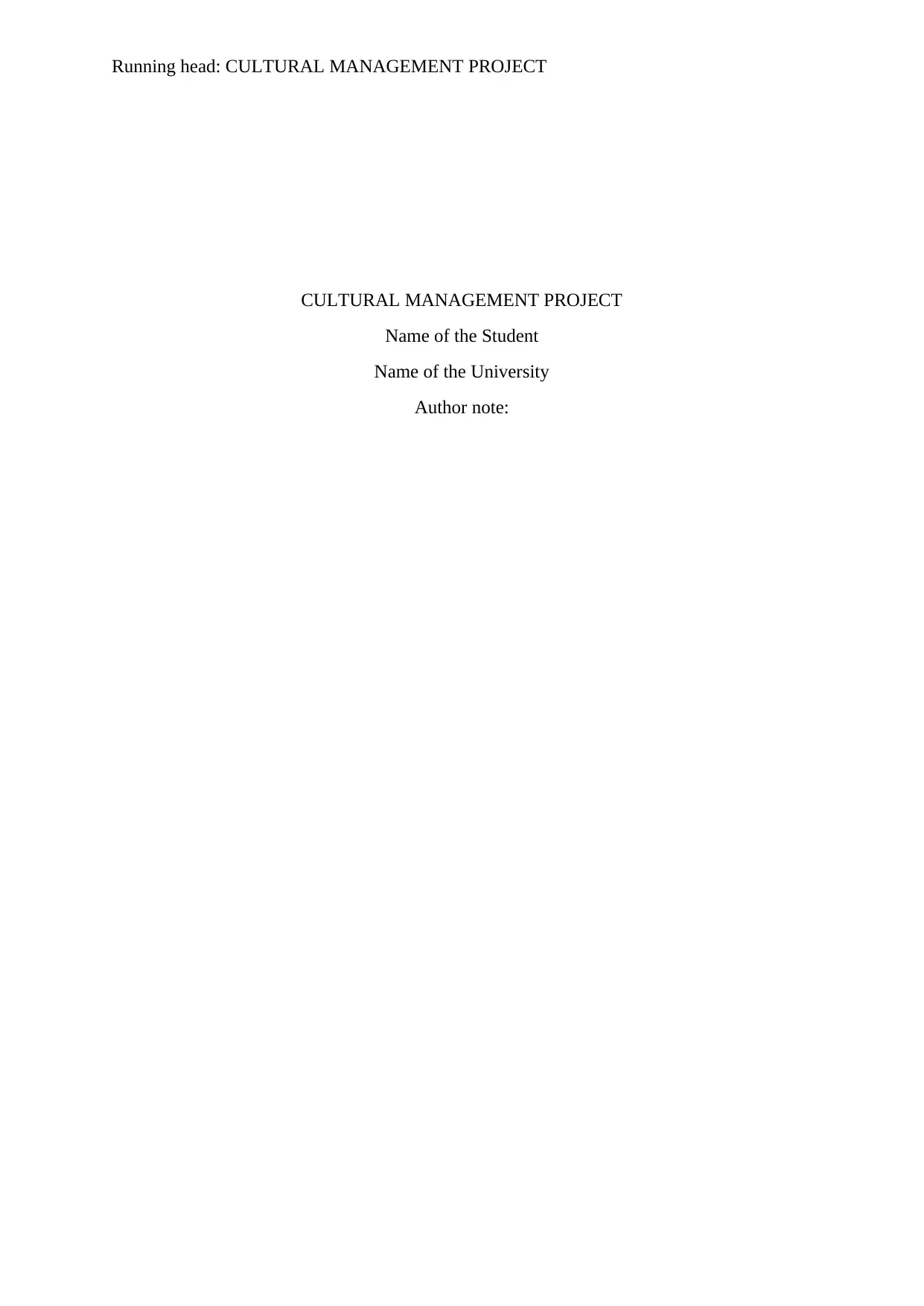
Running head: CULTURAL MANAGEMENT PROJECT
CULTURAL MANAGEMENT PROJECT
Name of the Student
Name of the University
Author note:
CULTURAL MANAGEMENT PROJECT
Name of the Student
Name of the University
Author note:
Paraphrase This Document
Need a fresh take? Get an instant paraphrase of this document with our AI Paraphraser
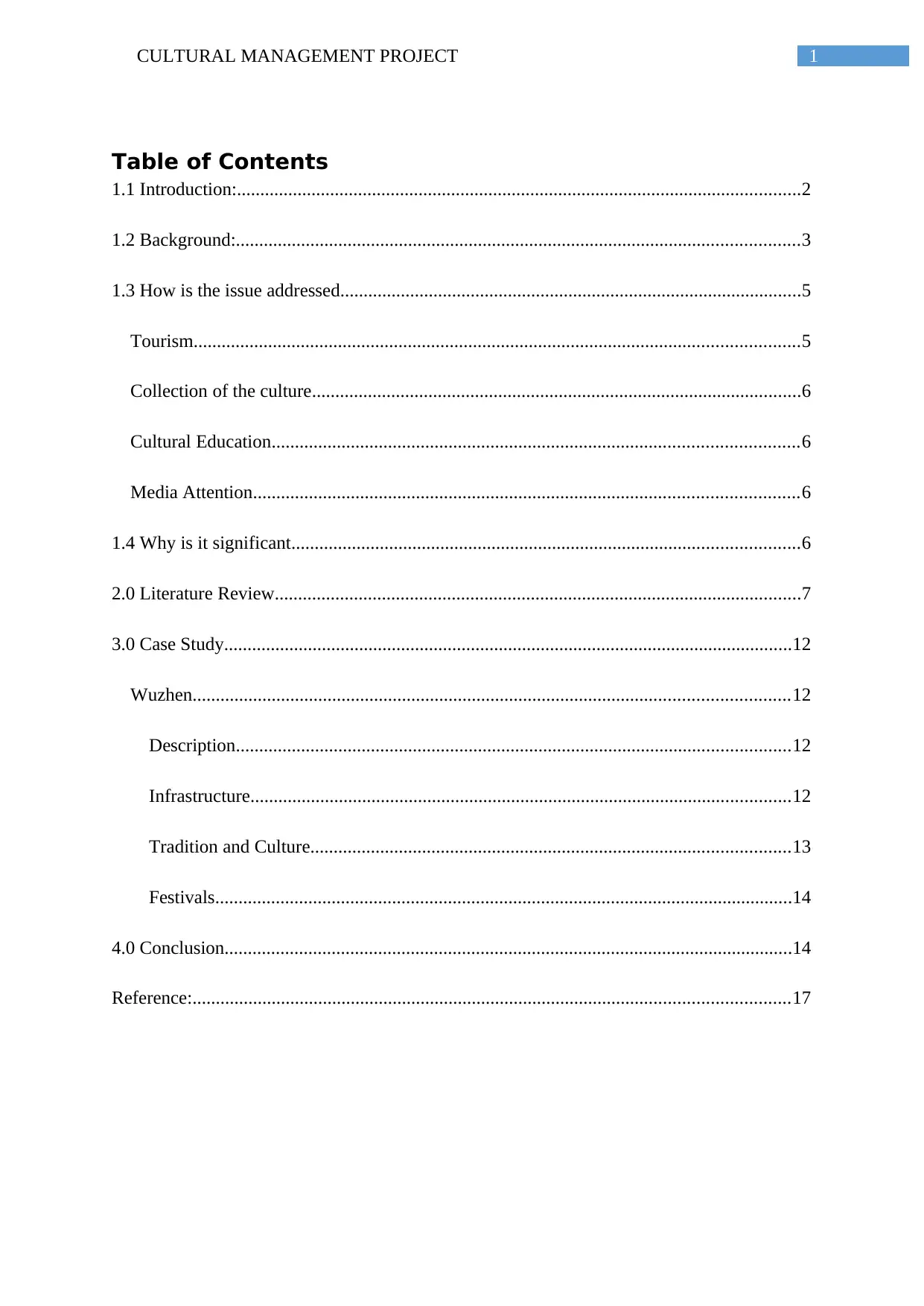
1CULTURAL MANAGEMENT PROJECT
Table of Contents
1.1 Introduction:.........................................................................................................................2
1.2 Background:.........................................................................................................................3
1.3 How is the issue addressed...................................................................................................5
Tourism..................................................................................................................................5
Collection of the culture.........................................................................................................6
Cultural Education.................................................................................................................6
Media Attention.....................................................................................................................6
1.4 Why is it significant.............................................................................................................6
2.0 Literature Review.................................................................................................................7
3.0 Case Study..........................................................................................................................12
Wuzhen................................................................................................................................12
Description.......................................................................................................................12
Infrastructure....................................................................................................................12
Tradition and Culture.......................................................................................................13
Festivals............................................................................................................................14
4.0 Conclusion..........................................................................................................................14
Reference:................................................................................................................................17
Table of Contents
1.1 Introduction:.........................................................................................................................2
1.2 Background:.........................................................................................................................3
1.3 How is the issue addressed...................................................................................................5
Tourism..................................................................................................................................5
Collection of the culture.........................................................................................................6
Cultural Education.................................................................................................................6
Media Attention.....................................................................................................................6
1.4 Why is it significant.............................................................................................................6
2.0 Literature Review.................................................................................................................7
3.0 Case Study..........................................................................................................................12
Wuzhen................................................................................................................................12
Description.......................................................................................................................12
Infrastructure....................................................................................................................12
Tradition and Culture.......................................................................................................13
Festivals............................................................................................................................14
4.0 Conclusion..........................................................................................................................14
Reference:................................................................................................................................17
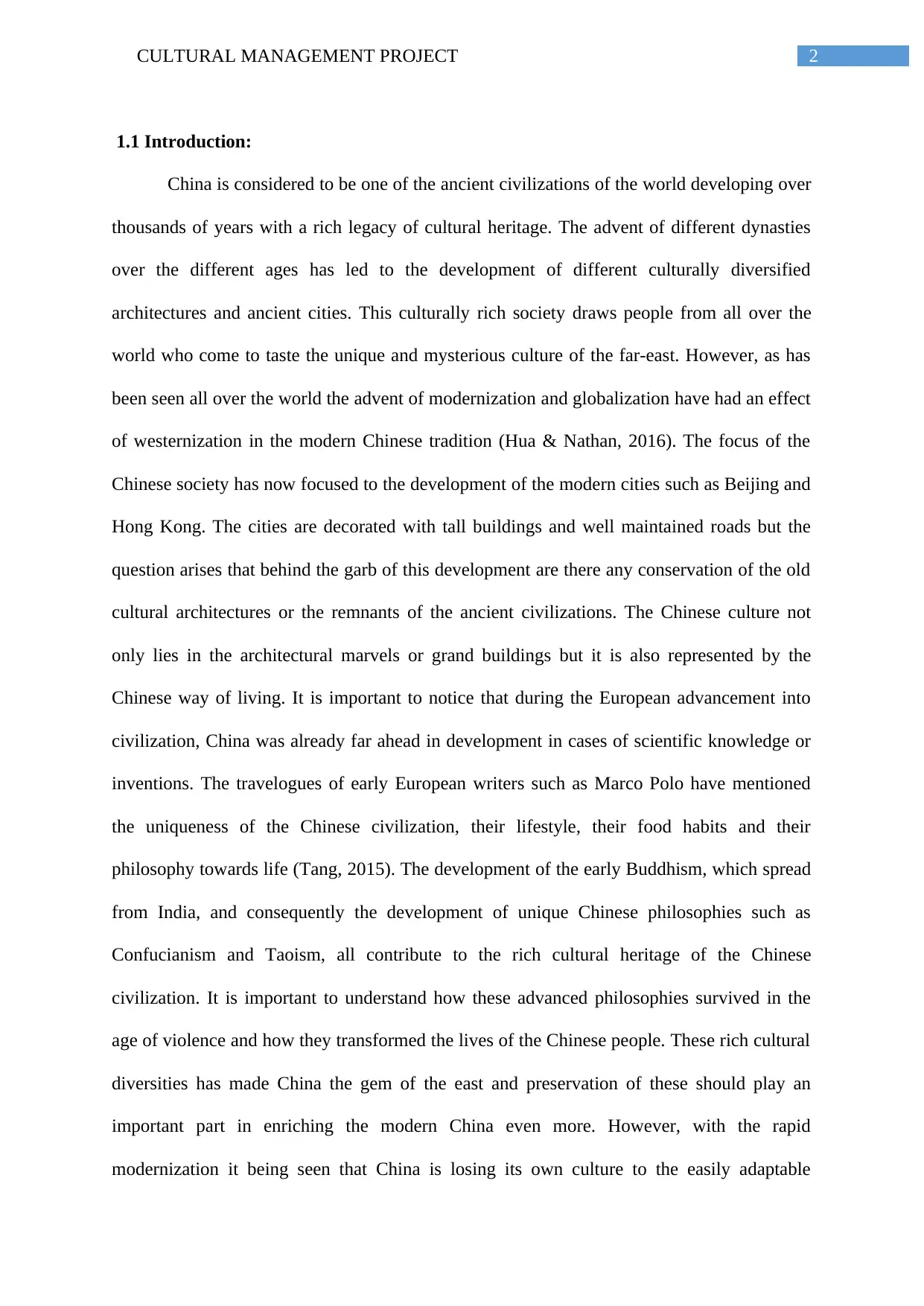
2CULTURAL MANAGEMENT PROJECT
1.1 Introduction:
China is considered to be one of the ancient civilizations of the world developing over
thousands of years with a rich legacy of cultural heritage. The advent of different dynasties
over the different ages has led to the development of different culturally diversified
architectures and ancient cities. This culturally rich society draws people from all over the
world who come to taste the unique and mysterious culture of the far-east. However, as has
been seen all over the world the advent of modernization and globalization have had an effect
of westernization in the modern Chinese tradition (Hua & Nathan, 2016). The focus of the
Chinese society has now focused to the development of the modern cities such as Beijing and
Hong Kong. The cities are decorated with tall buildings and well maintained roads but the
question arises that behind the garb of this development are there any conservation of the old
cultural architectures or the remnants of the ancient civilizations. The Chinese culture not
only lies in the architectural marvels or grand buildings but it is also represented by the
Chinese way of living. It is important to notice that during the European advancement into
civilization, China was already far ahead in development in cases of scientific knowledge or
inventions. The travelogues of early European writers such as Marco Polo have mentioned
the uniqueness of the Chinese civilization, their lifestyle, their food habits and their
philosophy towards life (Tang, 2015). The development of the early Buddhism, which spread
from India, and consequently the development of unique Chinese philosophies such as
Confucianism and Taoism, all contribute to the rich cultural heritage of the Chinese
civilization. It is important to understand how these advanced philosophies survived in the
age of violence and how they transformed the lives of the Chinese people. These rich cultural
diversities has made China the gem of the east and preservation of these should play an
important part in enriching the modern China even more. However, with the rapid
modernization it being seen that China is losing its own culture to the easily adaptable
1.1 Introduction:
China is considered to be one of the ancient civilizations of the world developing over
thousands of years with a rich legacy of cultural heritage. The advent of different dynasties
over the different ages has led to the development of different culturally diversified
architectures and ancient cities. This culturally rich society draws people from all over the
world who come to taste the unique and mysterious culture of the far-east. However, as has
been seen all over the world the advent of modernization and globalization have had an effect
of westernization in the modern Chinese tradition (Hua & Nathan, 2016). The focus of the
Chinese society has now focused to the development of the modern cities such as Beijing and
Hong Kong. The cities are decorated with tall buildings and well maintained roads but the
question arises that behind the garb of this development are there any conservation of the old
cultural architectures or the remnants of the ancient civilizations. The Chinese culture not
only lies in the architectural marvels or grand buildings but it is also represented by the
Chinese way of living. It is important to notice that during the European advancement into
civilization, China was already far ahead in development in cases of scientific knowledge or
inventions. The travelogues of early European writers such as Marco Polo have mentioned
the uniqueness of the Chinese civilization, their lifestyle, their food habits and their
philosophy towards life (Tang, 2015). The development of the early Buddhism, which spread
from India, and consequently the development of unique Chinese philosophies such as
Confucianism and Taoism, all contribute to the rich cultural heritage of the Chinese
civilization. It is important to understand how these advanced philosophies survived in the
age of violence and how they transformed the lives of the Chinese people. These rich cultural
diversities has made China the gem of the east and preservation of these should play an
important part in enriching the modern China even more. However, with the rapid
modernization it being seen that China is losing its own culture to the easily adaptable
⊘ This is a preview!⊘
Do you want full access?
Subscribe today to unlock all pages.

Trusted by 1+ million students worldwide
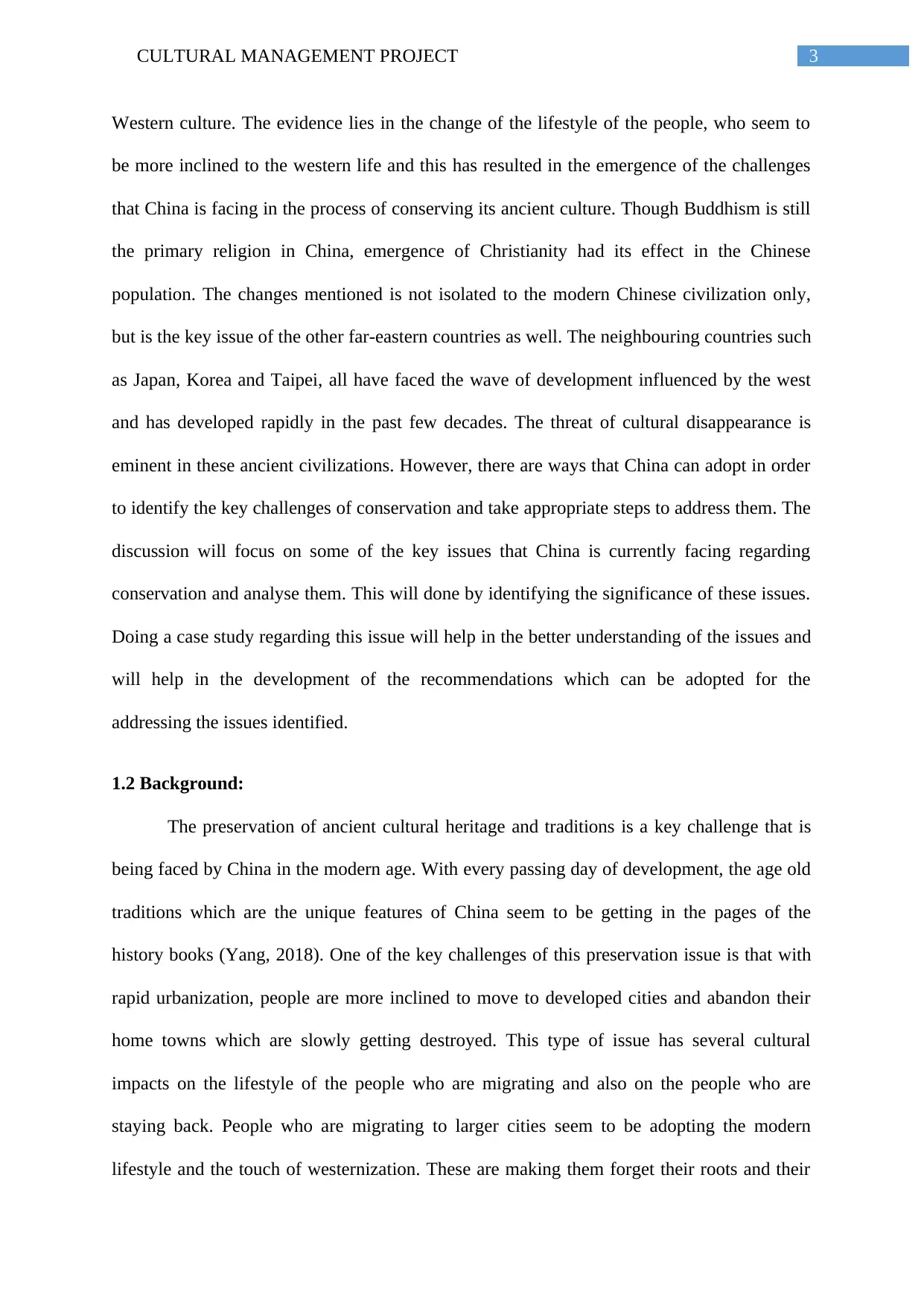
3CULTURAL MANAGEMENT PROJECT
Western culture. The evidence lies in the change of the lifestyle of the people, who seem to
be more inclined to the western life and this has resulted in the emergence of the challenges
that China is facing in the process of conserving its ancient culture. Though Buddhism is still
the primary religion in China, emergence of Christianity had its effect in the Chinese
population. The changes mentioned is not isolated to the modern Chinese civilization only,
but is the key issue of the other far-eastern countries as well. The neighbouring countries such
as Japan, Korea and Taipei, all have faced the wave of development influenced by the west
and has developed rapidly in the past few decades. The threat of cultural disappearance is
eminent in these ancient civilizations. However, there are ways that China can adopt in order
to identify the key challenges of conservation and take appropriate steps to address them. The
discussion will focus on some of the key issues that China is currently facing regarding
conservation and analyse them. This will done by identifying the significance of these issues.
Doing a case study regarding this issue will help in the better understanding of the issues and
will help in the development of the recommendations which can be adopted for the
addressing the issues identified.
1.2 Background:
The preservation of ancient cultural heritage and traditions is a key challenge that is
being faced by China in the modern age. With every passing day of development, the age old
traditions which are the unique features of China seem to be getting in the pages of the
history books (Yang, 2018). One of the key challenges of this preservation issue is that with
rapid urbanization, people are more inclined to move to developed cities and abandon their
home towns which are slowly getting destroyed. This type of issue has several cultural
impacts on the lifestyle of the people who are migrating and also on the people who are
staying back. People who are migrating to larger cities seem to be adopting the modern
lifestyle and the touch of westernization. These are making them forget their roots and their
Western culture. The evidence lies in the change of the lifestyle of the people, who seem to
be more inclined to the western life and this has resulted in the emergence of the challenges
that China is facing in the process of conserving its ancient culture. Though Buddhism is still
the primary religion in China, emergence of Christianity had its effect in the Chinese
population. The changes mentioned is not isolated to the modern Chinese civilization only,
but is the key issue of the other far-eastern countries as well. The neighbouring countries such
as Japan, Korea and Taipei, all have faced the wave of development influenced by the west
and has developed rapidly in the past few decades. The threat of cultural disappearance is
eminent in these ancient civilizations. However, there are ways that China can adopt in order
to identify the key challenges of conservation and take appropriate steps to address them. The
discussion will focus on some of the key issues that China is currently facing regarding
conservation and analyse them. This will done by identifying the significance of these issues.
Doing a case study regarding this issue will help in the better understanding of the issues and
will help in the development of the recommendations which can be adopted for the
addressing the issues identified.
1.2 Background:
The preservation of ancient cultural heritage and traditions is a key challenge that is
being faced by China in the modern age. With every passing day of development, the age old
traditions which are the unique features of China seem to be getting in the pages of the
history books (Yang, 2018). One of the key challenges of this preservation issue is that with
rapid urbanization, people are more inclined to move to developed cities and abandon their
home towns which are slowly getting destroyed. This type of issue has several cultural
impacts on the lifestyle of the people who are migrating and also on the people who are
staying back. People who are migrating to larger cities seem to be adopting the modern
lifestyle and the touch of westernization. These are making them forget their roots and their
Paraphrase This Document
Need a fresh take? Get an instant paraphrase of this document with our AI Paraphraser
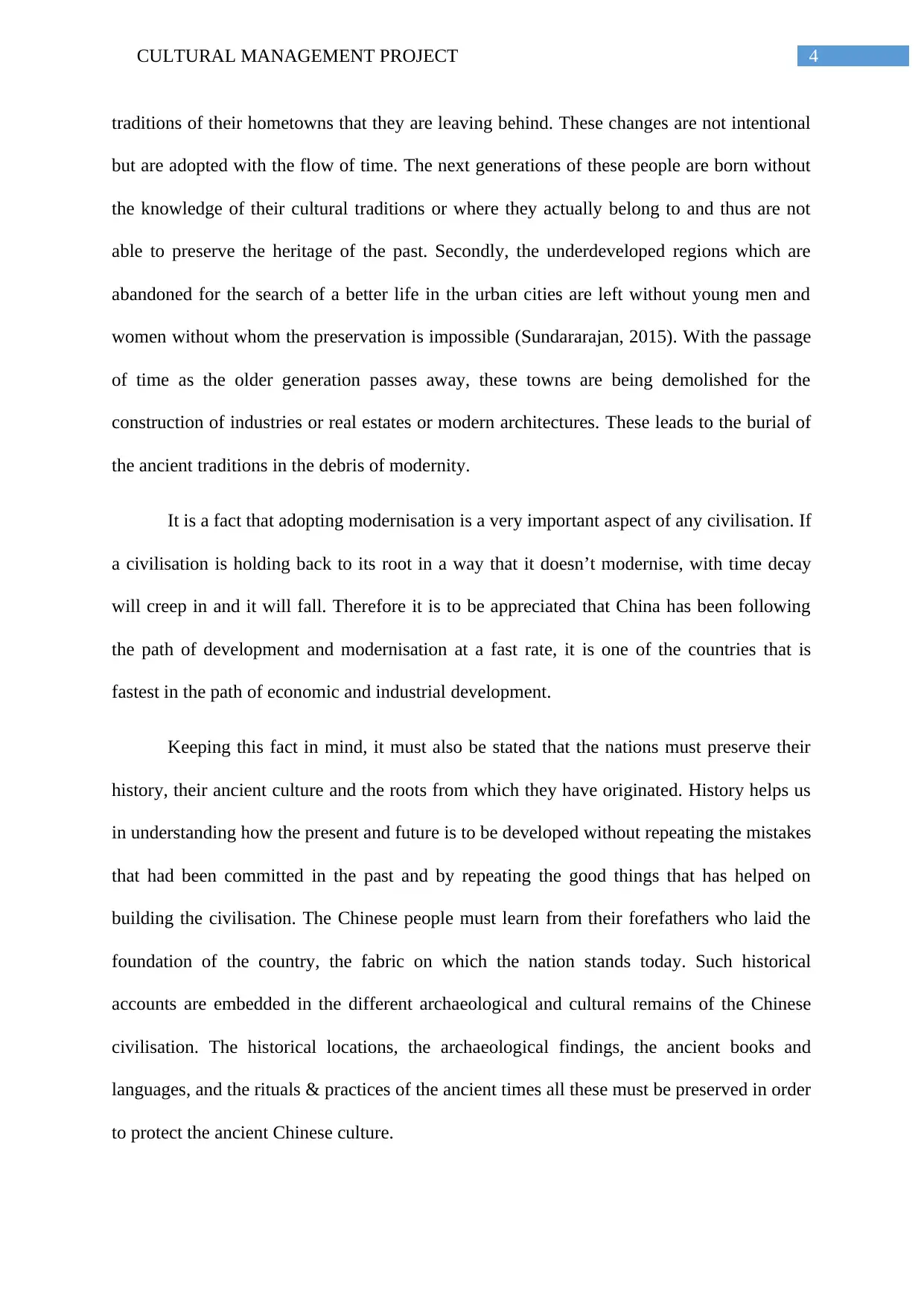
4CULTURAL MANAGEMENT PROJECT
traditions of their hometowns that they are leaving behind. These changes are not intentional
but are adopted with the flow of time. The next generations of these people are born without
the knowledge of their cultural traditions or where they actually belong to and thus are not
able to preserve the heritage of the past. Secondly, the underdeveloped regions which are
abandoned for the search of a better life in the urban cities are left without young men and
women without whom the preservation is impossible (Sundararajan, 2015). With the passage
of time as the older generation passes away, these towns are being demolished for the
construction of industries or real estates or modern architectures. These leads to the burial of
the ancient traditions in the debris of modernity.
It is a fact that adopting modernisation is a very important aspect of any civilisation. If
a civilisation is holding back to its root in a way that it doesn’t modernise, with time decay
will creep in and it will fall. Therefore it is to be appreciated that China has been following
the path of development and modernisation at a fast rate, it is one of the countries that is
fastest in the path of economic and industrial development.
Keeping this fact in mind, it must also be stated that the nations must preserve their
history, their ancient culture and the roots from which they have originated. History helps us
in understanding how the present and future is to be developed without repeating the mistakes
that had been committed in the past and by repeating the good things that has helped on
building the civilisation. The Chinese people must learn from their forefathers who laid the
foundation of the country, the fabric on which the nation stands today. Such historical
accounts are embedded in the different archaeological and cultural remains of the Chinese
civilisation. The historical locations, the archaeological findings, the ancient books and
languages, and the rituals & practices of the ancient times all these must be preserved in order
to protect the ancient Chinese culture.
traditions of their hometowns that they are leaving behind. These changes are not intentional
but are adopted with the flow of time. The next generations of these people are born without
the knowledge of their cultural traditions or where they actually belong to and thus are not
able to preserve the heritage of the past. Secondly, the underdeveloped regions which are
abandoned for the search of a better life in the urban cities are left without young men and
women without whom the preservation is impossible (Sundararajan, 2015). With the passage
of time as the older generation passes away, these towns are being demolished for the
construction of industries or real estates or modern architectures. These leads to the burial of
the ancient traditions in the debris of modernity.
It is a fact that adopting modernisation is a very important aspect of any civilisation. If
a civilisation is holding back to its root in a way that it doesn’t modernise, with time decay
will creep in and it will fall. Therefore it is to be appreciated that China has been following
the path of development and modernisation at a fast rate, it is one of the countries that is
fastest in the path of economic and industrial development.
Keeping this fact in mind, it must also be stated that the nations must preserve their
history, their ancient culture and the roots from which they have originated. History helps us
in understanding how the present and future is to be developed without repeating the mistakes
that had been committed in the past and by repeating the good things that has helped on
building the civilisation. The Chinese people must learn from their forefathers who laid the
foundation of the country, the fabric on which the nation stands today. Such historical
accounts are embedded in the different archaeological and cultural remains of the Chinese
civilisation. The historical locations, the archaeological findings, the ancient books and
languages, and the rituals & practices of the ancient times all these must be preserved in order
to protect the ancient Chinese culture.
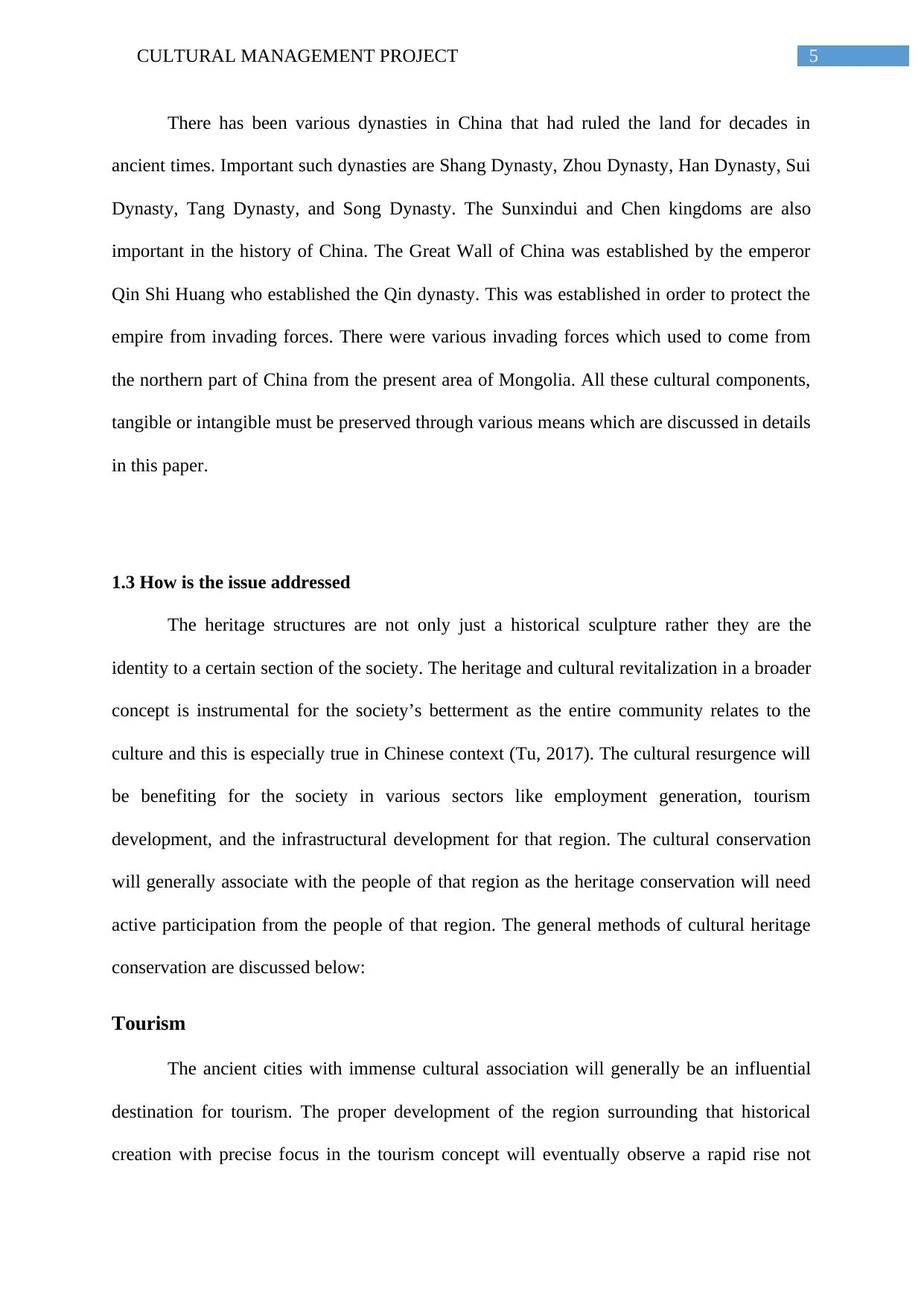
5CULTURAL MANAGEMENT PROJECT
There has been various dynasties in China that had ruled the land for decades in
ancient times. Important such dynasties are Shang Dynasty, Zhou Dynasty, Han Dynasty, Sui
Dynasty, Tang Dynasty, and Song Dynasty. The Sunxindui and Chen kingdoms are also
important in the history of China. The Great Wall of China was established by the emperor
Qin Shi Huang who established the Qin dynasty. This was established in order to protect the
empire from invading forces. There were various invading forces which used to come from
the northern part of China from the present area of Mongolia. All these cultural components,
tangible or intangible must be preserved through various means which are discussed in details
in this paper.
1.3 How is the issue addressed
The heritage structures are not only just a historical sculpture rather they are the
identity to a certain section of the society. The heritage and cultural revitalization in a broader
concept is instrumental for the society’s betterment as the entire community relates to the
culture and this is especially true in Chinese context (Tu, 2017). The cultural resurgence will
be benefiting for the society in various sectors like employment generation, tourism
development, and the infrastructural development for that region. The cultural conservation
will generally associate with the people of that region as the heritage conservation will need
active participation from the people of that region. The general methods of cultural heritage
conservation are discussed below:
Tourism
The ancient cities with immense cultural association will generally be an influential
destination for tourism. The proper development of the region surrounding that historical
creation with precise focus in the tourism concept will eventually observe a rapid rise not
There has been various dynasties in China that had ruled the land for decades in
ancient times. Important such dynasties are Shang Dynasty, Zhou Dynasty, Han Dynasty, Sui
Dynasty, Tang Dynasty, and Song Dynasty. The Sunxindui and Chen kingdoms are also
important in the history of China. The Great Wall of China was established by the emperor
Qin Shi Huang who established the Qin dynasty. This was established in order to protect the
empire from invading forces. There were various invading forces which used to come from
the northern part of China from the present area of Mongolia. All these cultural components,
tangible or intangible must be preserved through various means which are discussed in details
in this paper.
1.3 How is the issue addressed
The heritage structures are not only just a historical sculpture rather they are the
identity to a certain section of the society. The heritage and cultural revitalization in a broader
concept is instrumental for the society’s betterment as the entire community relates to the
culture and this is especially true in Chinese context (Tu, 2017). The cultural resurgence will
be benefiting for the society in various sectors like employment generation, tourism
development, and the infrastructural development for that region. The cultural conservation
will generally associate with the people of that region as the heritage conservation will need
active participation from the people of that region. The general methods of cultural heritage
conservation are discussed below:
Tourism
The ancient cities with immense cultural association will generally be an influential
destination for tourism. The proper development of the region surrounding that historical
creation with precise focus in the tourism concept will eventually observe a rapid rise not
⊘ This is a preview!⊘
Do you want full access?
Subscribe today to unlock all pages.

Trusted by 1+ million students worldwide
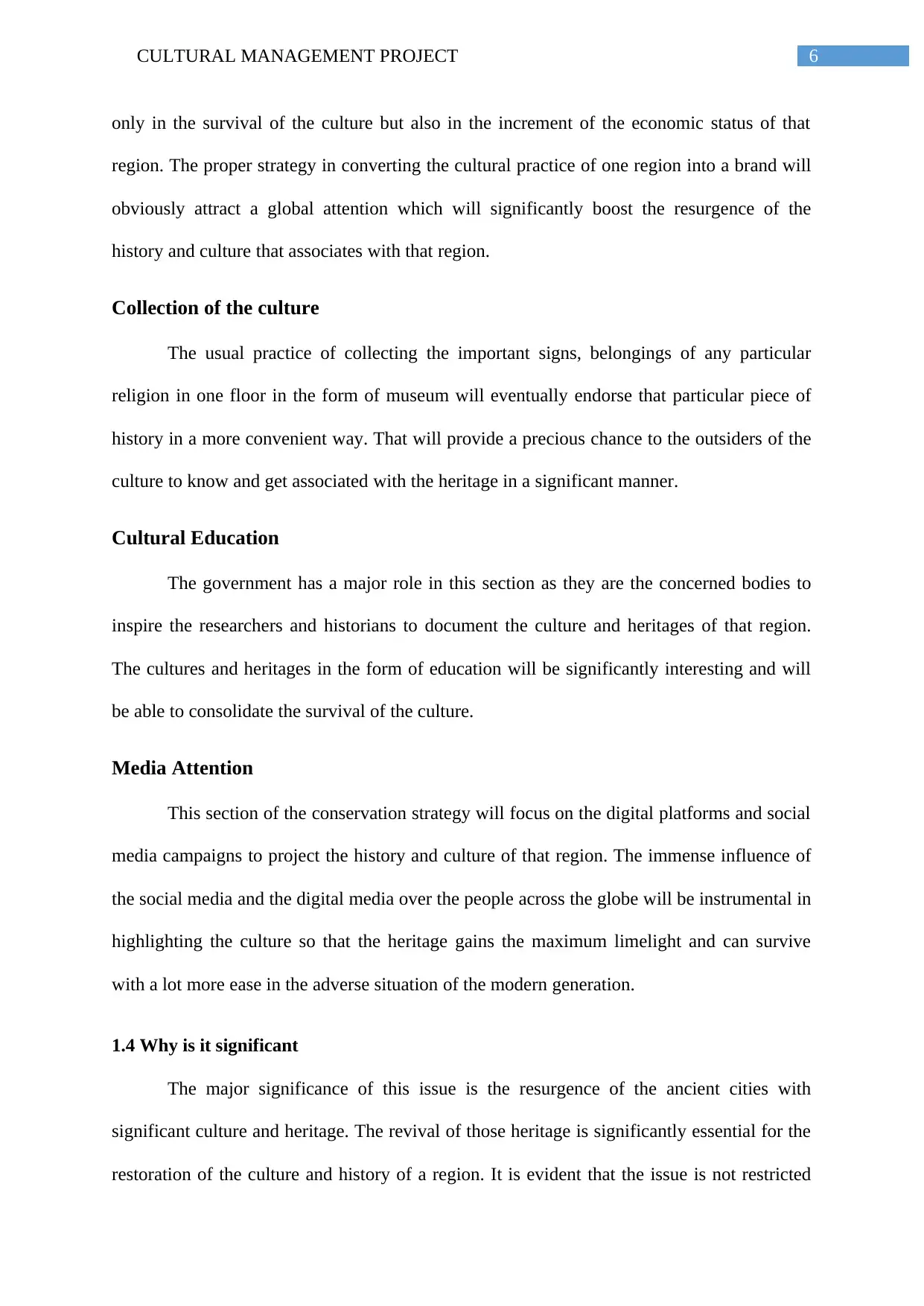
6CULTURAL MANAGEMENT PROJECT
only in the survival of the culture but also in the increment of the economic status of that
region. The proper strategy in converting the cultural practice of one region into a brand will
obviously attract a global attention which will significantly boost the resurgence of the
history and culture that associates with that region.
Collection of the culture
The usual practice of collecting the important signs, belongings of any particular
religion in one floor in the form of museum will eventually endorse that particular piece of
history in a more convenient way. That will provide a precious chance to the outsiders of the
culture to know and get associated with the heritage in a significant manner.
Cultural Education
The government has a major role in this section as they are the concerned bodies to
inspire the researchers and historians to document the culture and heritages of that region.
The cultures and heritages in the form of education will be significantly interesting and will
be able to consolidate the survival of the culture.
Media Attention
This section of the conservation strategy will focus on the digital platforms and social
media campaigns to project the history and culture of that region. The immense influence of
the social media and the digital media over the people across the globe will be instrumental in
highlighting the culture so that the heritage gains the maximum limelight and can survive
with a lot more ease in the adverse situation of the modern generation.
1.4 Why is it significant
The major significance of this issue is the resurgence of the ancient cities with
significant culture and heritage. The revival of those heritage is significantly essential for the
restoration of the culture and history of a region. It is evident that the issue is not restricted
only in the survival of the culture but also in the increment of the economic status of that
region. The proper strategy in converting the cultural practice of one region into a brand will
obviously attract a global attention which will significantly boost the resurgence of the
history and culture that associates with that region.
Collection of the culture
The usual practice of collecting the important signs, belongings of any particular
religion in one floor in the form of museum will eventually endorse that particular piece of
history in a more convenient way. That will provide a precious chance to the outsiders of the
culture to know and get associated with the heritage in a significant manner.
Cultural Education
The government has a major role in this section as they are the concerned bodies to
inspire the researchers and historians to document the culture and heritages of that region.
The cultures and heritages in the form of education will be significantly interesting and will
be able to consolidate the survival of the culture.
Media Attention
This section of the conservation strategy will focus on the digital platforms and social
media campaigns to project the history and culture of that region. The immense influence of
the social media and the digital media over the people across the globe will be instrumental in
highlighting the culture so that the heritage gains the maximum limelight and can survive
with a lot more ease in the adverse situation of the modern generation.
1.4 Why is it significant
The major significance of this issue is the resurgence of the ancient cities with
significant culture and heritage. The revival of those heritage is significantly essential for the
restoration of the culture and history of a region. It is evident that the issue is not restricted
Paraphrase This Document
Need a fresh take? Get an instant paraphrase of this document with our AI Paraphraser
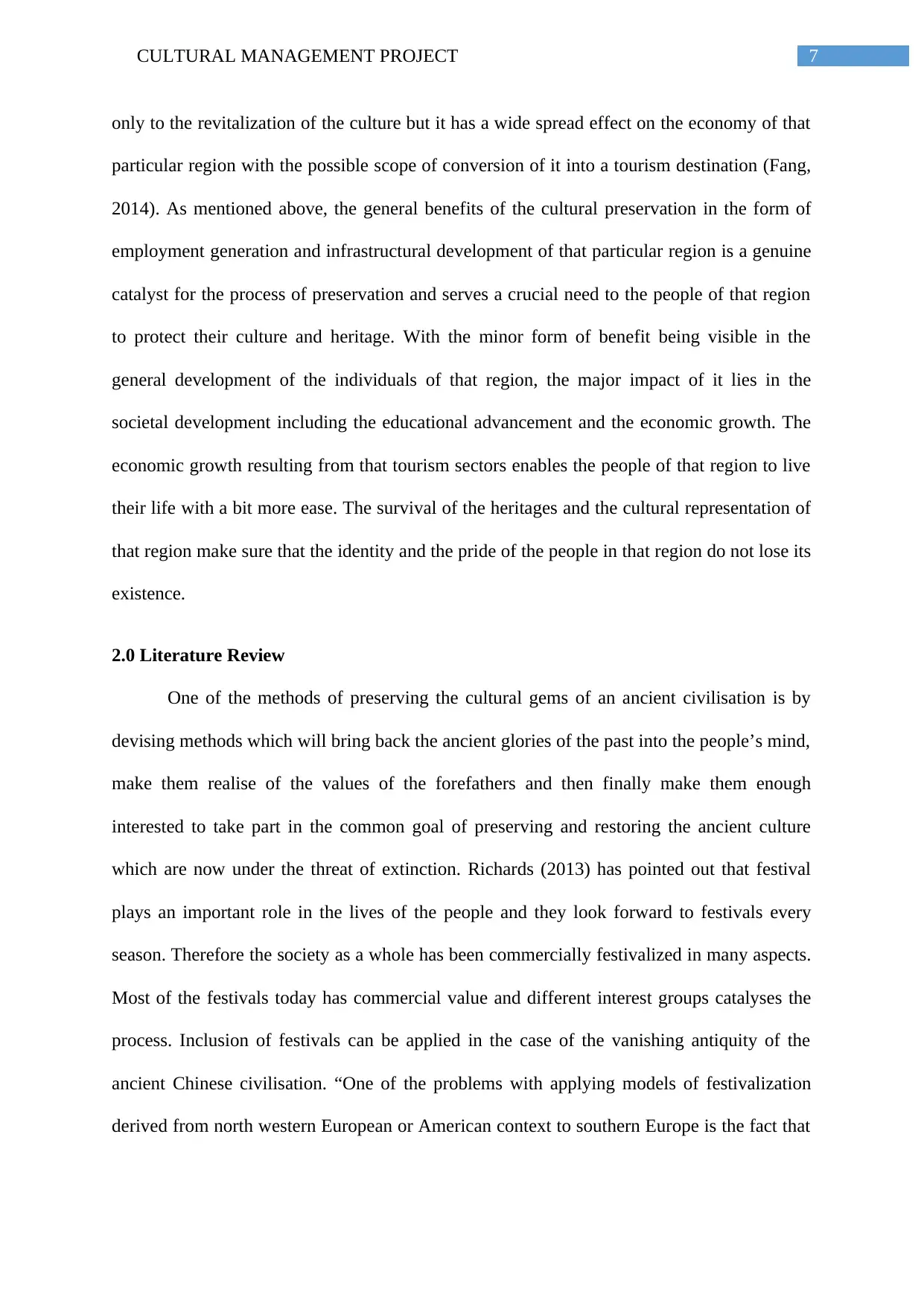
7CULTURAL MANAGEMENT PROJECT
only to the revitalization of the culture but it has a wide spread effect on the economy of that
particular region with the possible scope of conversion of it into a tourism destination (Fang,
2014). As mentioned above, the general benefits of the cultural preservation in the form of
employment generation and infrastructural development of that particular region is a genuine
catalyst for the process of preservation and serves a crucial need to the people of that region
to protect their culture and heritage. With the minor form of benefit being visible in the
general development of the individuals of that region, the major impact of it lies in the
societal development including the educational advancement and the economic growth. The
economic growth resulting from that tourism sectors enables the people of that region to live
their life with a bit more ease. The survival of the heritages and the cultural representation of
that region make sure that the identity and the pride of the people in that region do not lose its
existence.
2.0 Literature Review
One of the methods of preserving the cultural gems of an ancient civilisation is by
devising methods which will bring back the ancient glories of the past into the people’s mind,
make them realise of the values of the forefathers and then finally make them enough
interested to take part in the common goal of preserving and restoring the ancient culture
which are now under the threat of extinction. Richards (2013) has pointed out that festival
plays an important role in the lives of the people and they look forward to festivals every
season. Therefore the society as a whole has been commercially festivalized in many aspects.
Most of the festivals today has commercial value and different interest groups catalyses the
process. Inclusion of festivals can be applied in the case of the vanishing antiquity of the
ancient Chinese civilisation. “One of the problems with applying models of festivalization
derived from north western European or American context to southern Europe is the fact that
only to the revitalization of the culture but it has a wide spread effect on the economy of that
particular region with the possible scope of conversion of it into a tourism destination (Fang,
2014). As mentioned above, the general benefits of the cultural preservation in the form of
employment generation and infrastructural development of that particular region is a genuine
catalyst for the process of preservation and serves a crucial need to the people of that region
to protect their culture and heritage. With the minor form of benefit being visible in the
general development of the individuals of that region, the major impact of it lies in the
societal development including the educational advancement and the economic growth. The
economic growth resulting from that tourism sectors enables the people of that region to live
their life with a bit more ease. The survival of the heritages and the cultural representation of
that region make sure that the identity and the pride of the people in that region do not lose its
existence.
2.0 Literature Review
One of the methods of preserving the cultural gems of an ancient civilisation is by
devising methods which will bring back the ancient glories of the past into the people’s mind,
make them realise of the values of the forefathers and then finally make them enough
interested to take part in the common goal of preserving and restoring the ancient culture
which are now under the threat of extinction. Richards (2013) has pointed out that festival
plays an important role in the lives of the people and they look forward to festivals every
season. Therefore the society as a whole has been commercially festivalized in many aspects.
Most of the festivals today has commercial value and different interest groups catalyses the
process. Inclusion of festivals can be applied in the case of the vanishing antiquity of the
ancient Chinese civilisation. “One of the problems with applying models of festivalization
derived from north western European or American context to southern Europe is the fact that
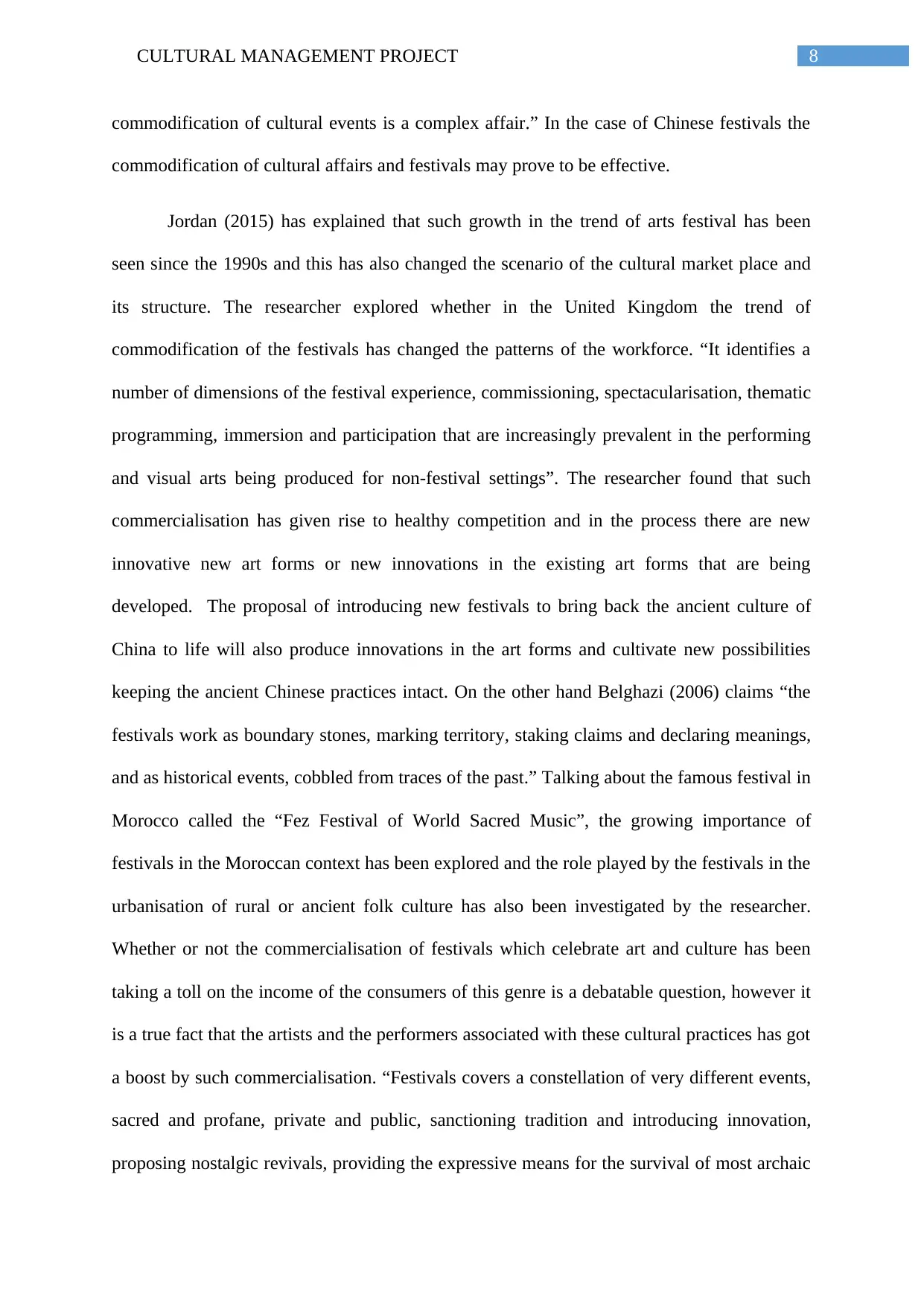
8CULTURAL MANAGEMENT PROJECT
commodification of cultural events is a complex affair.” In the case of Chinese festivals the
commodification of cultural affairs and festivals may prove to be effective.
Jordan (2015) has explained that such growth in the trend of arts festival has been
seen since the 1990s and this has also changed the scenario of the cultural market place and
its structure. The researcher explored whether in the United Kingdom the trend of
commodification of the festivals has changed the patterns of the workforce. “It identifies a
number of dimensions of the festival experience, commissioning, spectacularisation, thematic
programming, immersion and participation that are increasingly prevalent in the performing
and visual arts being produced for non-festival settings”. The researcher found that such
commercialisation has given rise to healthy competition and in the process there are new
innovative new art forms or new innovations in the existing art forms that are being
developed. The proposal of introducing new festivals to bring back the ancient culture of
China to life will also produce innovations in the art forms and cultivate new possibilities
keeping the ancient Chinese practices intact. On the other hand Belghazi (2006) claims “the
festivals work as boundary stones, marking territory, staking claims and declaring meanings,
and as historical events, cobbled from traces of the past.” Talking about the famous festival in
Morocco called the “Fez Festival of World Sacred Music”, the growing importance of
festivals in the Moroccan context has been explored and the role played by the festivals in the
urbanisation of rural or ancient folk culture has also been investigated by the researcher.
Whether or not the commercialisation of festivals which celebrate art and culture has been
taking a toll on the income of the consumers of this genre is a debatable question, however it
is a true fact that the artists and the performers associated with these cultural practices has got
a boost by such commercialisation. “Festivals covers a constellation of very different events,
sacred and profane, private and public, sanctioning tradition and introducing innovation,
proposing nostalgic revivals, providing the expressive means for the survival of most archaic
commodification of cultural events is a complex affair.” In the case of Chinese festivals the
commodification of cultural affairs and festivals may prove to be effective.
Jordan (2015) has explained that such growth in the trend of arts festival has been
seen since the 1990s and this has also changed the scenario of the cultural market place and
its structure. The researcher explored whether in the United Kingdom the trend of
commodification of the festivals has changed the patterns of the workforce. “It identifies a
number of dimensions of the festival experience, commissioning, spectacularisation, thematic
programming, immersion and participation that are increasingly prevalent in the performing
and visual arts being produced for non-festival settings”. The researcher found that such
commercialisation has given rise to healthy competition and in the process there are new
innovative new art forms or new innovations in the existing art forms that are being
developed. The proposal of introducing new festivals to bring back the ancient culture of
China to life will also produce innovations in the art forms and cultivate new possibilities
keeping the ancient Chinese practices intact. On the other hand Belghazi (2006) claims “the
festivals work as boundary stones, marking territory, staking claims and declaring meanings,
and as historical events, cobbled from traces of the past.” Talking about the famous festival in
Morocco called the “Fez Festival of World Sacred Music”, the growing importance of
festivals in the Moroccan context has been explored and the role played by the festivals in the
urbanisation of rural or ancient folk culture has also been investigated by the researcher.
Whether or not the commercialisation of festivals which celebrate art and culture has been
taking a toll on the income of the consumers of this genre is a debatable question, however it
is a true fact that the artists and the performers associated with these cultural practices has got
a boost by such commercialisation. “Festivals covers a constellation of very different events,
sacred and profane, private and public, sanctioning tradition and introducing innovation,
proposing nostalgic revivals, providing the expressive means for the survival of most archaic
⊘ This is a preview!⊘
Do you want full access?
Subscribe today to unlock all pages.

Trusted by 1+ million students worldwide
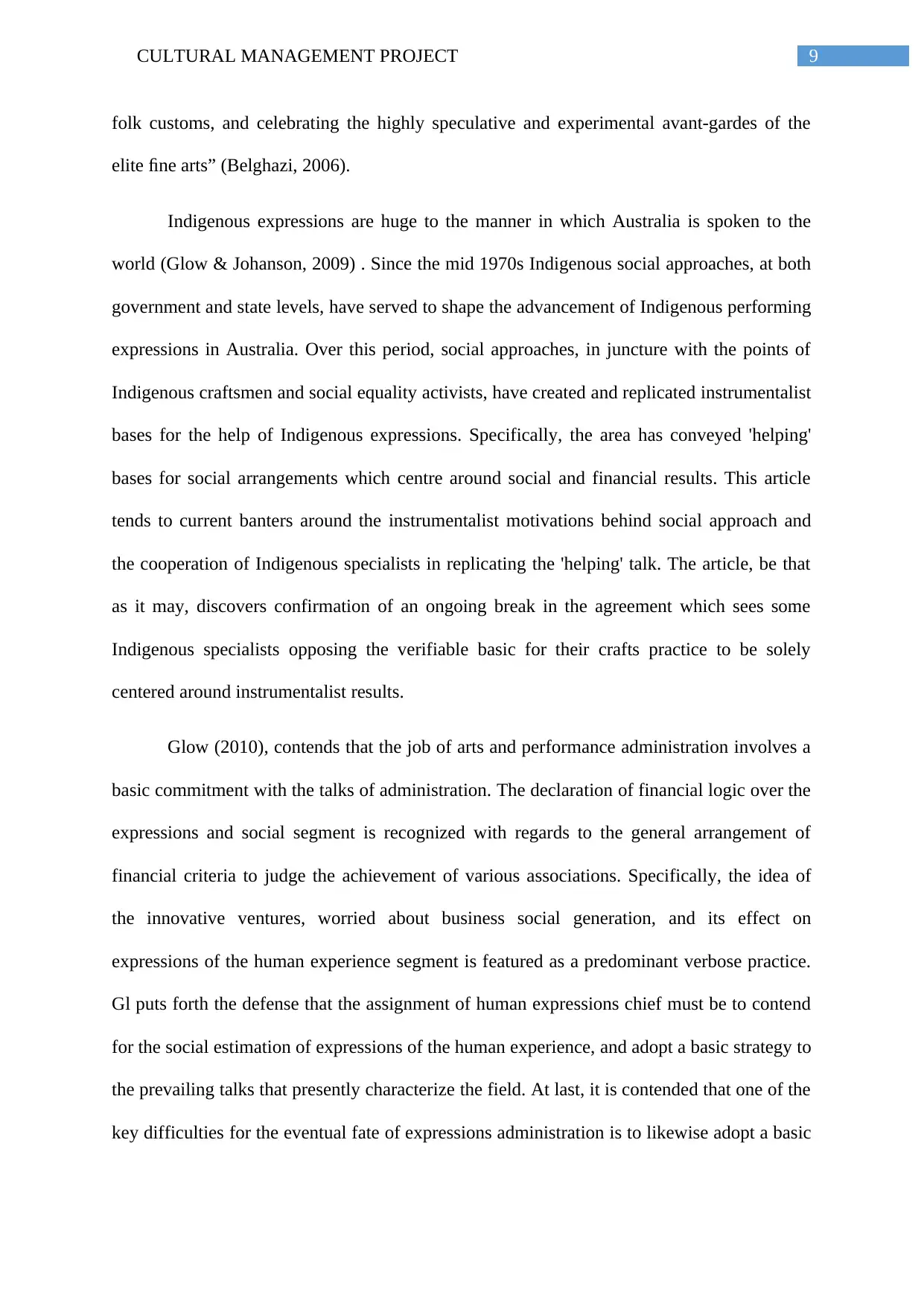
9CULTURAL MANAGEMENT PROJECT
folk customs, and celebrating the highly speculative and experimental avant-gardes of the
elite fine arts” (Belghazi, 2006).
Indigenous expressions are huge to the manner in which Australia is spoken to the
world (Glow & Johanson, 2009) . Since the mid 1970s Indigenous social approaches, at both
government and state levels, have served to shape the advancement of Indigenous performing
expressions in Australia. Over this period, social approaches, in juncture with the points of
Indigenous craftsmen and social equality activists, have created and replicated instrumentalist
bases for the help of Indigenous expressions. Specifically, the area has conveyed 'helping'
bases for social arrangements which centre around social and financial results. This article
tends to current banters around the instrumentalist motivations behind social approach and
the cooperation of Indigenous specialists in replicating the 'helping' talk. The article, be that
as it may, discovers confirmation of an ongoing break in the agreement which sees some
Indigenous specialists opposing the verifiable basic for their crafts practice to be solely
centered around instrumentalist results.
Glow (2010), contends that the job of arts and performance administration involves a
basic commitment with the talks of administration. The declaration of financial logic over the
expressions and social segment is recognized with regards to the general arrangement of
financial criteria to judge the achievement of various associations. Specifically, the idea of
the innovative ventures, worried about business social generation, and its effect on
expressions of the human experience segment is featured as a predominant verbose practice.
Gl puts forth the defense that the assignment of human expressions chief must be to contend
for the social estimation of expressions of the human experience, and adopt a basic strategy to
the prevailing talks that presently characterize the field. At last, it is contended that one of the
key difficulties for the eventual fate of expressions administration is to likewise adopt a basic
folk customs, and celebrating the highly speculative and experimental avant-gardes of the
elite fine arts” (Belghazi, 2006).
Indigenous expressions are huge to the manner in which Australia is spoken to the
world (Glow & Johanson, 2009) . Since the mid 1970s Indigenous social approaches, at both
government and state levels, have served to shape the advancement of Indigenous performing
expressions in Australia. Over this period, social approaches, in juncture with the points of
Indigenous craftsmen and social equality activists, have created and replicated instrumentalist
bases for the help of Indigenous expressions. Specifically, the area has conveyed 'helping'
bases for social arrangements which centre around social and financial results. This article
tends to current banters around the instrumentalist motivations behind social approach and
the cooperation of Indigenous specialists in replicating the 'helping' talk. The article, be that
as it may, discovers confirmation of an ongoing break in the agreement which sees some
Indigenous specialists opposing the verifiable basic for their crafts practice to be solely
centered around instrumentalist results.
Glow (2010), contends that the job of arts and performance administration involves a
basic commitment with the talks of administration. The declaration of financial logic over the
expressions and social segment is recognized with regards to the general arrangement of
financial criteria to judge the achievement of various associations. Specifically, the idea of
the innovative ventures, worried about business social generation, and its effect on
expressions of the human experience segment is featured as a predominant verbose practice.
Gl puts forth the defense that the assignment of human expressions chief must be to contend
for the social estimation of expressions of the human experience, and adopt a basic strategy to
the prevailing talks that presently characterize the field. At last, it is contended that one of the
key difficulties for the eventual fate of expressions administration is to likewise adopt a basic
Paraphrase This Document
Need a fresh take? Get an instant paraphrase of this document with our AI Paraphraser
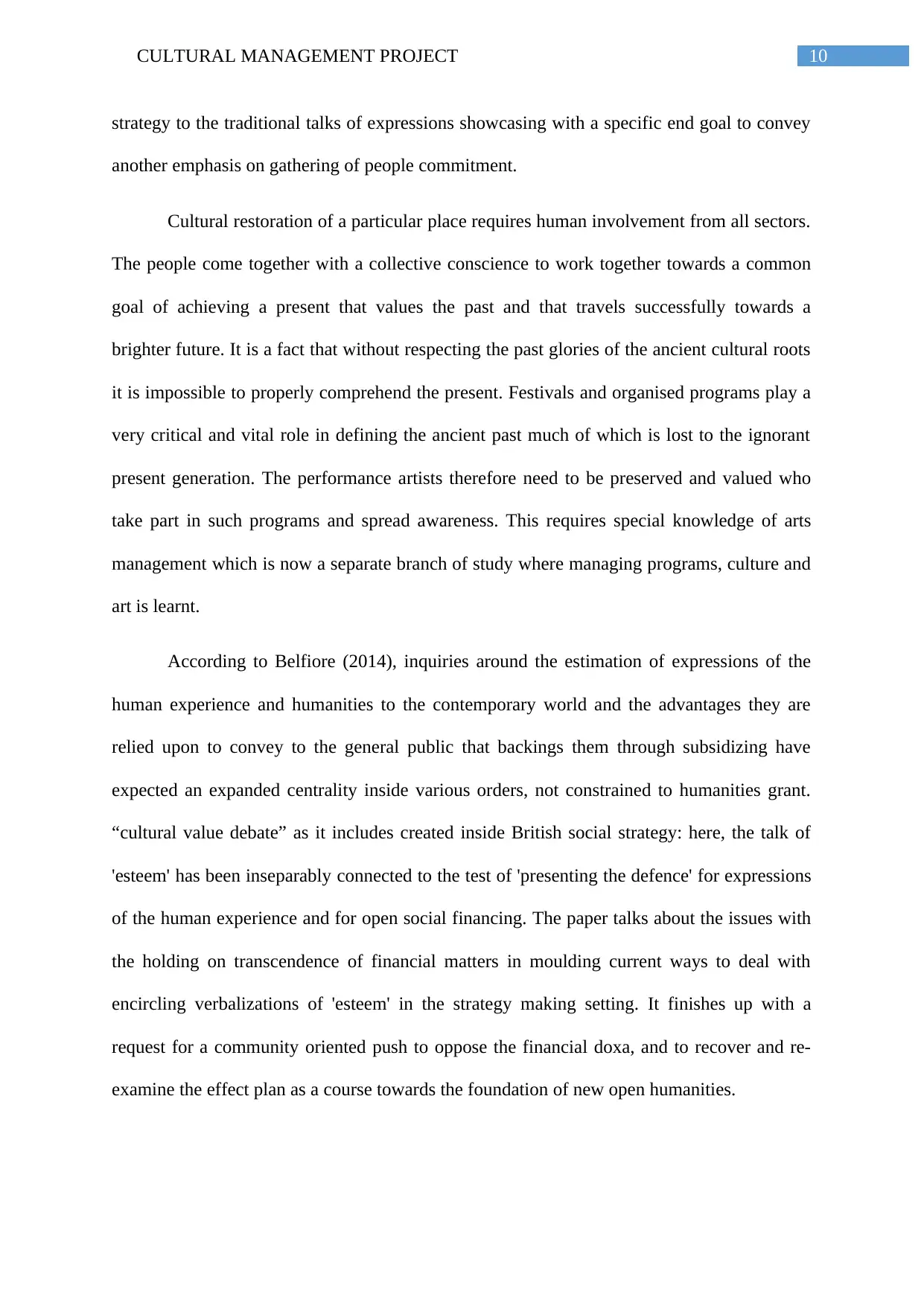
10CULTURAL MANAGEMENT PROJECT
strategy to the traditional talks of expressions showcasing with a specific end goal to convey
another emphasis on gathering of people commitment.
Cultural restoration of a particular place requires human involvement from all sectors.
The people come together with a collective conscience to work together towards a common
goal of achieving a present that values the past and that travels successfully towards a
brighter future. It is a fact that without respecting the past glories of the ancient cultural roots
it is impossible to properly comprehend the present. Festivals and organised programs play a
very critical and vital role in defining the ancient past much of which is lost to the ignorant
present generation. The performance artists therefore need to be preserved and valued who
take part in such programs and spread awareness. This requires special knowledge of arts
management which is now a separate branch of study where managing programs, culture and
art is learnt.
According to Belfiore (2014), inquiries around the estimation of expressions of the
human experience and humanities to the contemporary world and the advantages they are
relied upon to convey to the general public that backings them through subsidizing have
expected an expanded centrality inside various orders, not constrained to humanities grant.
“cultural value debate” as it includes created inside British social strategy: here, the talk of
'esteem' has been inseparably connected to the test of 'presenting the defence' for expressions
of the human experience and for open social financing. The paper talks about the issues with
the holding on transcendence of financial matters in moulding current ways to deal with
encircling verbalizations of 'esteem' in the strategy making setting. It finishes up with a
request for a community oriented push to oppose the financial doxa, and to recover and re-
examine the effect plan as a course towards the foundation of new open humanities.
strategy to the traditional talks of expressions showcasing with a specific end goal to convey
another emphasis on gathering of people commitment.
Cultural restoration of a particular place requires human involvement from all sectors.
The people come together with a collective conscience to work together towards a common
goal of achieving a present that values the past and that travels successfully towards a
brighter future. It is a fact that without respecting the past glories of the ancient cultural roots
it is impossible to properly comprehend the present. Festivals and organised programs play a
very critical and vital role in defining the ancient past much of which is lost to the ignorant
present generation. The performance artists therefore need to be preserved and valued who
take part in such programs and spread awareness. This requires special knowledge of arts
management which is now a separate branch of study where managing programs, culture and
art is learnt.
According to Belfiore (2014), inquiries around the estimation of expressions of the
human experience and humanities to the contemporary world and the advantages they are
relied upon to convey to the general public that backings them through subsidizing have
expected an expanded centrality inside various orders, not constrained to humanities grant.
“cultural value debate” as it includes created inside British social strategy: here, the talk of
'esteem' has been inseparably connected to the test of 'presenting the defence' for expressions
of the human experience and for open social financing. The paper talks about the issues with
the holding on transcendence of financial matters in moulding current ways to deal with
encircling verbalizations of 'esteem' in the strategy making setting. It finishes up with a
request for a community oriented push to oppose the financial doxa, and to recover and re-
examine the effect plan as a course towards the foundation of new open humanities.
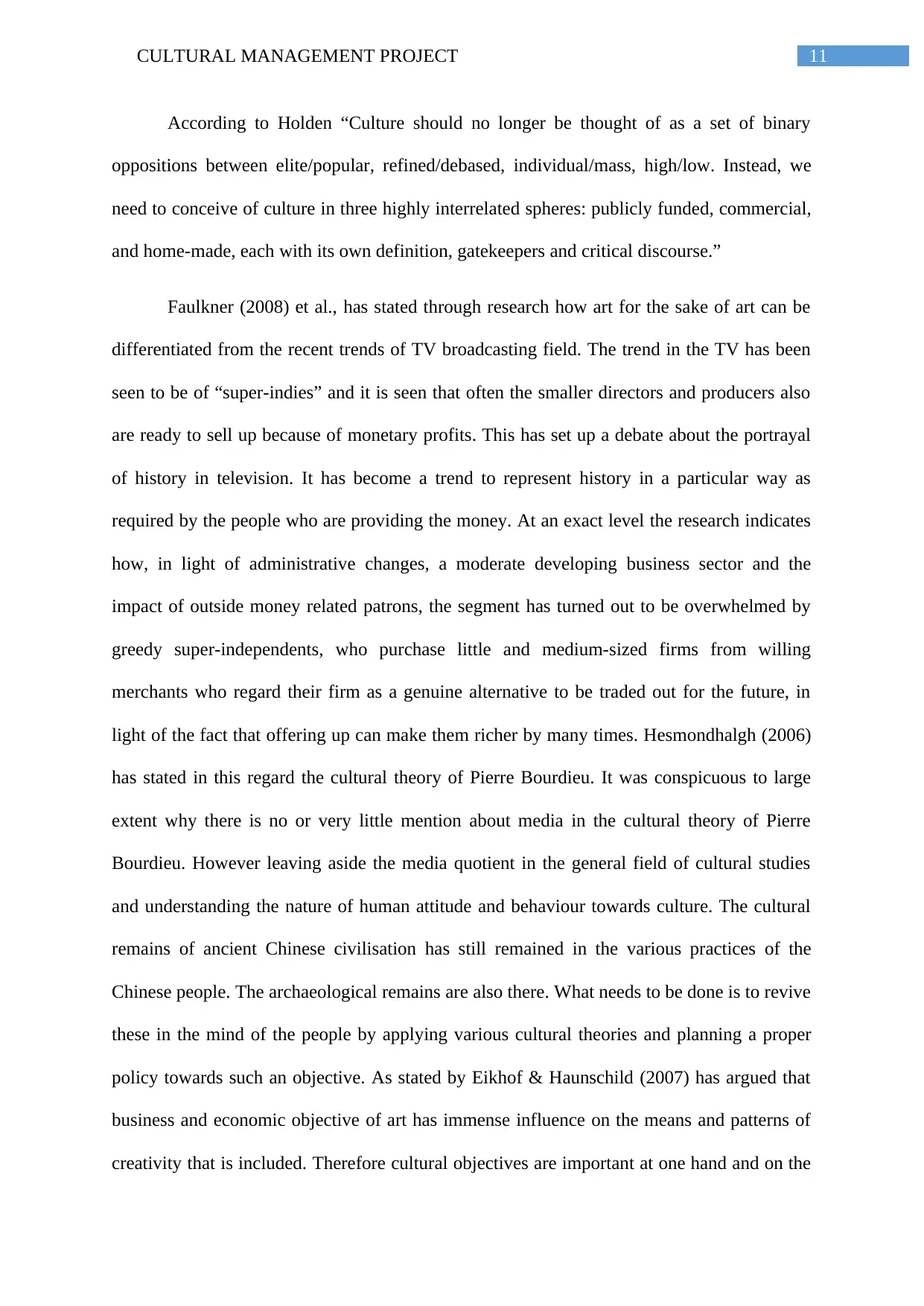
11CULTURAL MANAGEMENT PROJECT
According to Holden “Culture should no longer be thought of as a set of binary
oppositions between elite/popular, refined/debased, individual/mass, high/low. Instead, we
need to conceive of culture in three highly interrelated spheres: publicly funded, commercial,
and home-made, each with its own definition, gatekeepers and critical discourse.”
Faulkner (2008) et al., has stated through research how art for the sake of art can be
differentiated from the recent trends of TV broadcasting field. The trend in the TV has been
seen to be of “super-indies” and it is seen that often the smaller directors and producers also
are ready to sell up because of monetary profits. This has set up a debate about the portrayal
of history in television. It has become a trend to represent history in a particular way as
required by the people who are providing the money. At an exact level the research indicates
how, in light of administrative changes, a moderate developing business sector and the
impact of outside money related patrons, the segment has turned out to be overwhelmed by
greedy super-independents, who purchase little and medium-sized firms from willing
merchants who regard their firm as a genuine alternative to be traded out for the future, in
light of the fact that offering up can make them richer by many times. Hesmondhalgh (2006)
has stated in this regard the cultural theory of Pierre Bourdieu. It was conspicuous to large
extent why there is no or very little mention about media in the cultural theory of Pierre
Bourdieu. However leaving aside the media quotient in the general field of cultural studies
and understanding the nature of human attitude and behaviour towards culture. The cultural
remains of ancient Chinese civilisation has still remained in the various practices of the
Chinese people. The archaeological remains are also there. What needs to be done is to revive
these in the mind of the people by applying various cultural theories and planning a proper
policy towards such an objective. As stated by Eikhof & Haunschild (2007) has argued that
business and economic objective of art has immense influence on the means and patterns of
creativity that is included. Therefore cultural objectives are important at one hand and on the
According to Holden “Culture should no longer be thought of as a set of binary
oppositions between elite/popular, refined/debased, individual/mass, high/low. Instead, we
need to conceive of culture in three highly interrelated spheres: publicly funded, commercial,
and home-made, each with its own definition, gatekeepers and critical discourse.”
Faulkner (2008) et al., has stated through research how art for the sake of art can be
differentiated from the recent trends of TV broadcasting field. The trend in the TV has been
seen to be of “super-indies” and it is seen that often the smaller directors and producers also
are ready to sell up because of monetary profits. This has set up a debate about the portrayal
of history in television. It has become a trend to represent history in a particular way as
required by the people who are providing the money. At an exact level the research indicates
how, in light of administrative changes, a moderate developing business sector and the
impact of outside money related patrons, the segment has turned out to be overwhelmed by
greedy super-independents, who purchase little and medium-sized firms from willing
merchants who regard their firm as a genuine alternative to be traded out for the future, in
light of the fact that offering up can make them richer by many times. Hesmondhalgh (2006)
has stated in this regard the cultural theory of Pierre Bourdieu. It was conspicuous to large
extent why there is no or very little mention about media in the cultural theory of Pierre
Bourdieu. However leaving aside the media quotient in the general field of cultural studies
and understanding the nature of human attitude and behaviour towards culture. The cultural
remains of ancient Chinese civilisation has still remained in the various practices of the
Chinese people. The archaeological remains are also there. What needs to be done is to revive
these in the mind of the people by applying various cultural theories and planning a proper
policy towards such an objective. As stated by Eikhof & Haunschild (2007) has argued that
business and economic objective of art has immense influence on the means and patterns of
creativity that is included. Therefore cultural objectives are important at one hand and on the
⊘ This is a preview!⊘
Do you want full access?
Subscribe today to unlock all pages.

Trusted by 1+ million students worldwide
1 out of 20
Related Documents
Your All-in-One AI-Powered Toolkit for Academic Success.
+13062052269
info@desklib.com
Available 24*7 on WhatsApp / Email
![[object Object]](/_next/static/media/star-bottom.7253800d.svg)
Unlock your academic potential
Copyright © 2020–2025 A2Z Services. All Rights Reserved. Developed and managed by ZUCOL.



